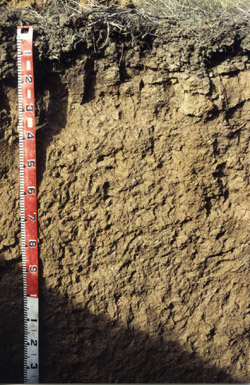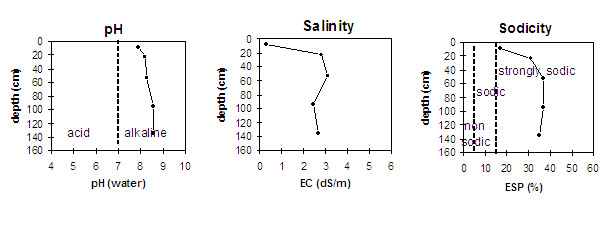LP15
Location: Kerang
Australian Soil Classification: Epicalcareous-Epihypersodic, Self-Mulching, Brown VERTOSOL
General Landscape Description: Flat plain.
Local Soil Name: Kerang Clay
Soil Profile Morphology: (Eastern Face)
Surface Soil
| A1 | 0-15 cm | Greyish brown (10YR5/2); heavy clay; self mulching surface condition; strong coarse polyhedral, breaking down to strong fine polyhedral structure; strong consistence dry; contains very few (<2%) carbonate nodules (2 mm in size); pH 7.9; sharp and smooth change to: |  LP15 Profile |
Subsoil | |||
| B21 | 15-30 cm | Yellowish brown (10YR5/4); medium heavy clay; strong coarse prismatic, breaking down to blocky structure; strong consistence moist; contains few (2-10%) carbonate nodules (2-10 mm in size) as well as very few (<2%) gypsum crystals; pH 8.2; wavy change to: | |
| B22 | 30-75 cm | Brown (10YR5/3); medium heavy clay; strong coarse sub-angular blocky structure; firm consistence moist; contains few (2-10%) carbonate nodules (2-10 mm in size) as well as very few (<2%) gypsum crystals; pH 8.3; diffuse and smooth change to: | |
| B23 | 75-115 cm | Brown (10YR5/3); medium heavy clay; weak coarse lenticular structure; firm consistence moist; contains very few (<2%) carbonate nodules (2-10 mm in size); pH 8.6; diffuse change to: | |
| B24 | 115+ cm | Yellowish brown (10YR5/4) with yellowish red (5YR5/6) mottles; heavy clay; weak coarse lenticular structure; contains slickensides; firm consistence moist; contains few (2-10%) carbonate nodules (2-10 mm in size); pH 8.6. | |
Soil Profile Morphology: (Southern Face)
Surface Soil
| A1 | 0-15 cm | Greyish brown (10YR5/2); medium heavy clay; pH 7.3: | |
| A2 | 15-30 cm | Light grey (10YR7/2d) sporadically bleached; light clay; contains magnesium nodules with staining and rusty root channel mottling; pH 7.7: | |
Subsoil | |||
| B21 | 30+ cm | Brown (10YR5/3) with strong brown (7.5YR5/6) mottles; medium heavy clay; strong coarse prismatic, breaking down to strong blocky structure; strong consistence moist; contains few (2%) carbonate nodules; pH 8.1. | |
Key Profile Features:
- Self mulching surface condition.
- High clay content throughout profile.
- Accumulation of carbonates throughout the profile.
- Vertic properties (i.e. significant shrink-swell characteristics).
- Accumulation of gypsum crystals in the upper subsoil.
Eastern Face
pH | Salinity Rating | |||
Surface (A1 horizon) | Slightly Alkaline | Low | Strongly Sodic | Slight1 |
Subsoil (B21 horizon) | Moderately Alkaline | Extreme | Strongly Sodic | None2 |
Deeper subsoil (at 100-130 cm) | Strongly Alkaline | Extreme | Extremely Sodic | None2 |

| The surface is slightly alkaline. The subsoil is moderately alkaline becoming strongly alkaline with depth. | The salinity rating is low in the surface soil becoming extreme in the subsoil. | The surface and upper subsoil is strongly sodic. The deeper subsoil is extremely sodic. |
Horizon | Horizon Depth (cm) | pH (water) | pH (CaCl2) | EC dS/m | Total Nitrogen % | Organic Carbon % | Exchangeable Cations | Field Capacity pF2.5 | Wilting Point pF4.2 | |||
Ca | Mg | K | Na | |||||||||
meq/100g | ||||||||||||
A1 | 0-15 | 7.9 | 6.9 | 0.31 | 0.18 | 2.0 | 10.3 | 9.7 | 2.4 | 4.5 | 37.9 | 25.3 |
B21 | 15-30 | 8.2 | 7.9 | 2.79 | 12.0 | 12.4 | 1.8 | 11.8 | 44.2 | 27.5 | ||
B22 | 30-75 | 8.3 | 8.0 | 3.09 | 9.6 | 14.0 | 1.8 | 14.4 | ||||
B23 | 75-115 | 8.6 | 8.2 | 2.47 | 8.5 | 13.1 | 1.7 | 13.5 | ||||
B24 | 115+ | 8.6 | 8.2 | 2.65 | 7.5 | 13.8 | 12.3 | 1.6 | ||||
Management Considerations:
Surface (A) Horizon
- The surface soil is self-mulching which provides a good seed bed that is friable and easily worked.
- The surface (A1) is strongly sodic with moderate dispersion after rainfall. This indicates that tillage or over-stocking of the soil whilst in a moist to wet condition may result in structural degradation (e.g. surface sealing, increased cloddiness) occurring. Raindrop action on bare soil may have a similar effect, so it is important to maintain surface cover. Gypsum application may assist in improving surface soil structural conditions on such soils.
- The presence of sporadic bleach in the subsurface (A2) horizon, on the southerly side of the pit, indicates that periodic waterlogging occurs above the slowly permeable subsoil.
- The high wilting point value (25%) indicates that plants will be unable to utilise light rains when the soil is relatively dry.
- The levels of organic carbon measured at the pit site is moderate (this may or may not be representative of the whole paddock).
- The levels of total nitrogen measured at this pit site is moderate. However, this is best assessed by taking a bulked sample from across the paddock.
Subsoil (B) Horizons
- The subsoil is extremely saline from 20 cm and is likely to restrict the growth of salt sensitive plant species (e.g. faba beans, linseed, chickpeas and lupins).
- The densely and coarsely structured subsoil (B21) is strongly sodic with a low exchangeable calcium to magnesium ratio (0.7). The extremely high salinity level has probably contributed to the decrease in dispersion to nil (with only slight dispersion after remoulding and is not likely to restrict water movement as significantly as would occur if the soil was not saline. Nevertheless, subsoil permeability will be low due to the low porosity of the clayey horizons.
- The strongly alkaline deeper subsoil suggests that some nutrients (e.g. iron, manganese, zinc, copper) may be poorly available to deep rooted plants and that deficiencies may occur. Deficiencies can be determined by plant tissue analysis.
- The high level of exchangeable sodium and magnesium in the subsoil may also result in nutrient imbalances and may even have a toxic effect on some plants.
- The subsoil displays vertic properties (i.e. slickensides, lenticular structure etc.) which indicates that significant shrinking and swelling occurs with wetting and drying cycles. This may disturb the roots of some plant species and has engineering implications (e.g. disturbance to building foundations and fence lines).
Landholder Comments:
- This property has been a buffer strip for twenty years and has not been cropped or irrigated.
- There is upward seepage from a deeplead 300 feet down.
- The profile itself is very dry and this could be due to the tile drainage in the neighboring paddock. When there is water movement, it moves through prefered pathways in a pipe like pattern.
Profile Described By: Mark Imhof, John Martin and Sonia Thompson (May 1994).


